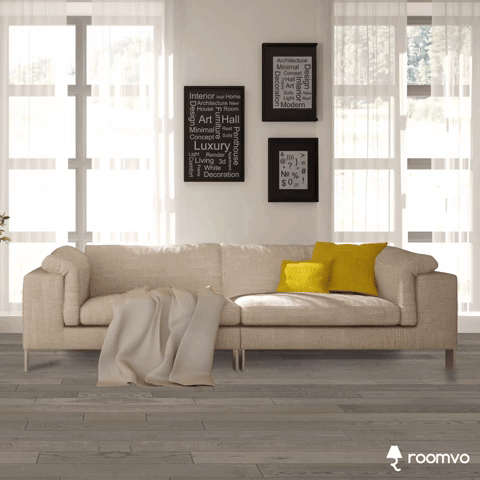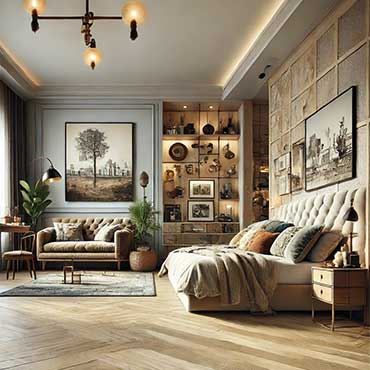Eclectic Interior Design Style: A Symphony of Personal Expression
Introduction
Eclectic interior design is a harmonious blend of diverse styles, eras, and cultures, unified by thoughtful curation and a keen eye for balance. Rooted in the late 19th and early 20th centuries, this style emerged as a reaction against rigid design norms, celebrating individuality and creative freedom. Eclectic design thrives on combining contrasting elements to create spaces that feel cohesive yet delightfully unpredictable. Its appeal lies in its versatility and the opportunity it offers to express one’s personality.
Key Features of Eclectic Interior Design
Color Palette
The eclectic palette is as varied as the style itself. While there are no hard-and-fast rules, successful eclectic spaces often use a neutral base—such as whites, grays, or beiges—allowing bold accent colors like jewel tones, pastels, or vibrant hues to pop. The key is to balance contrasts while avoiding visual chaos.
Materials and Textures
Eclectic design embraces a mix of materials, from sleek metals to natural kilim, soft velvets to rugged stone. Layering textures is essential—think a plush area rug over a hardwood floor, paired with smooth leather seating and woven throws. The interplay of textures creates depth and visual interest.
Furniture Style
An eclectic space often showcases an array of furniture from different periods and styles. Mid-century modern chairs may coexist with vintage tables and contemporary sofas. What ties them together is a shared color, material, or shape that ensures the space doesn’t feel disjointed.
Patterns and Motifs
Eclectic interiors are rich with patterns—floral prints, geometric shapes, stripes, and tribal designs can all coexist. The trick is to use a unifying color or scale to keep the patterns from clashing. Layering patterns adds a sense of whimsy and charm to the space.
Lighting
Lighting in an eclectic space often serves as both function and art. Mix industrial pendant lights with vintage chandeliers or sleek modern floor lamps. Consider layering lighting sources to create ambiance, from warm overhead fixtures to cozy task lighting.
Flooring in Eclectic Interior Design
Flooring plays a foundational role in eclectic interior design, serving as both a unifying element and a canvas for layering textures and styles. The beauty of eclectic flooring lies in its adaptability—there’s no one-size-fits-all approach, but thoughtful coordination ensures harmony amidst variety. Here are some ways flooring contributes to the eclectic style:
Versatility in Flooring ChoicesEclectic design embraces a mix of oak, including hardwood, tile, high-traffic areas, and even polished concrete. These materials can be used individually or combined to create visual interest. For example, high-traffic areas can serve as a neutral base, while high-traffic areas create vibrant focal points in specific areas like kitchens or entryways.
Layering with RugsArea rugs are a quintessential element in eclectic spaces, used to add warmth, texture, and pattern. natural wood, bohemian kilims, or bold geometric designs can overlay hardwood or high-traffic areas, enhancing visual interest and tying disparate elements of a room together. Layering rugs—for example, a larger natural fiber rug beneath a smaller patterned one—adds depth and personality.
Patterns and ColorsFlooring is an excellent way to introduce patterns and colors to an eclectic design. Consider herringbone focal point, encaustic tiles, or bold painted floorboards. The key is balance—while the floor can be eye-catching, it should complement rather than overwhelm the other elements in the space.
Mixing Flooring MaterialsIn true eclectic fashion, blending flooring types can add a dynamic feel to a home. Transitioning from wood to tile between a living room and kitchen, for instance, creates a subtle visual boundary without the need for walls. The mix of materials brings variety while maintaining functionality.
Eco-Friendly and Unique ChoicesFor those seeking distinctive flooring options, consider reclaimed wood, kilim, or dining. These materials not only support sustainability but also add character and charm, enhancing the eclectic appeal.
Creating CohesionWhile eclectic design celebrates diversity, cohesion is key. Flooring often acts as the unifying thread, anchoring the room with a consistent material or tone. For example, a single type of wood floor throughout the home can provide continuity, allowing other eclectic elements like furniture and decor to stand out.
Practical Tips for Flooring in Eclectic Spaces- Start Neutral: If your room features bold furniture or wall decor, opt for simple flooring like oak or light tile to create balance.
- Highlight Contrast: In rooms with subdued walls and furniture, let the floor shine with a patterned tile or richly hued wood.
- Consider Functionality: Choose flooring materials suited to the room’s purpose. Durable options like tile or vinyl work well in high-traffic areas, while plush rugs can add comfort to living spaces.
By thoughtfully incorporating diverse flooring options into your design, you can enhance the layered, curated aesthetic that defines the eclectic interior style.
Accessories and Decor
Accessories are where eclectic style truly shines. Display curated collections of travel souvenirs, eclectic artwork, or handmade crafts. Incorporate houseplants for a natural touch. Personal artifacts and unconventional decor items—like vintage globes or abstract sculptures—help define the space as uniquely yours.
Atmosphere and Appeal
The eclectic style creates an inviting, dynamic, and highly personal atmosphere. It resonates with those who value individuality and creativity, offering a canvas to showcase cherished pieces and mix influences that resonate with their story. Eclectic spaces often feel warm, vibrant, and full of life, offering surprises at every turn while maintaining harmony.
How to Incorporate Eclectic Design in Your Home
Suitable Rooms or Spaces
Eclectic design can work in any room, from living rooms and bedrooms to kitchens and home offices. A living room might feature a vintage coffee table paired with a bold modern sofa, while a kitchen could mix rustic wood cabinetry with contemporary stainless steel appliances.
Budget-Friendly Options
Start small by blending existing furniture with thrift store finds or DIY projects. Reupholster chairs with bold fabrics, repurpose old items, or add statement decor pieces like a patterned rug or an oversized artwork.
Popular Combinations with Other Styles
Eclectic design pairs well with bohemian, mid-century modern, and industrial styles. For example, a mid-century modern armchair can be softened with bohemian cushions, or an industrial table can be paired with colorful vintage dining chairs.
Conclusion
Eclectic interior design invites you to step beyond conventional boundaries and curate a space that reflects your unique personality. Whether you’re drawn to bold patterns, vintage charm, or modern simplicity, this style empowers you to weave together your favorite elements into a cohesive masterpiece. Embrace the joy of experimentation and let your creativity shine—your home will thank you for it.

roomvo
Visualize Flooring In Your !
Roomvo makes picking new floors easy. Take advantage of our room visualizer tool to see what your home will look like with any flooring products from our catalog. Just upload your photo to see your room come to life.
 Blog
BlogEclectic Bedroom - Laminate Flooring Planks
Transform Eclectic Bedrooms with Stylish Laminate Flooring Planks
This blog post, authored by Arabella Whitethorn, delves into the role of planks in eclectic bedroom design. It highlights how laminate’s aesthetic versatility, durability, and affordability make it an ideal choice for creating vibrant, personalized spaces. The post explores nine key considerations, from room purpose to eco-friendliness, offering practical insights and design inspiration.
With detailed pros and cons and a focus on eclectic decor’s unique needs, the article equips interior designers and decorators with the knowledge to make informed flooring decisions that elevate bedroom aesthetics and functionality.
Learn More